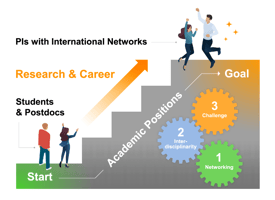Since the inauguration of President Donald Trump on January 21, 2025, the headlines have looked...
What is the future of collaborative research?
Last year, the winners of one of science’s biggest awards, the prestigious Shaw Prize, shared one major feature in common: all of the research achievements involved collaboration. That includes cross-institutional collaboration and even cross-border collaboration. Whether it was to identify the genetic and molecular mechanisms underlying sickle cell anemia, develop the arithmetic theory of thin groups and the affine sieve, or conceive and construct major astronomical observatories and facilities, scientific collaboration proved to be a vital part of these groundbreaking discoveries.

The rise in collaborative research has revolutionized the world of science. Since the 1970s, large studies with more than eight authors grew at five times the rate of single or paired author studies; on PubMed, the average study eclipsed six authors per article by 2020. By the same year, one quarter of studies involved cross-border collaboration.
You can read our extensive break-down of the current state of science’s collaborative research revolution here. But one major question remains: what’s next? Will these trends continue as is, till the average study involves three countries and ten authors? Or do nascent developments in geopolitics and technology have the potential to actually reduce collaboration in the future? And what new collaborative methods will emerge? Read on to find out.
Gaps and issues with collaborative research
Although international collaboration has become a prominent part of the research world, there are several key remaining gaps that the community collectively needs to address.
- Diseconomies of scale can lead to inefficiencies
Research shows that having more team members leads to a greater dissemination of research—to a certain point. According to a study in Science, when team size grew beyond twenty, more authors no longer led to more citations. So the maximum team size that led to greater productivity was around twenty.
- Collaboration doesn’t necessarily help with “wicked problems”
Wicked problems in research are scientific challenges that are particularly difficult solve. As defined by the theorists Horst Rittel and Melvin Webber, these problems cannot be studied through trial and error or with a control group. They do not have objective ‘true’ or ‘false’ solutions, but rather subjective ‘better’ and ‘worse’ solutions. A few wicked problems include the climate crisis, the mental health crisis, and systemic racism and inequality.
- Collaboration can disseminate certain inequalities
The benefits of scientific collaboration are not always shared equally. Experts point out that large-scale collaborations tend to follow the initiative and agenda of the largest scale, the most powerful partner involved—and the same institution or individual receives the lion’s share of the credit, whereas smaller partners receive only downstream benefits.
- Geopolitical tensions mean there are limits to collaboration
Since the 2010s, scientific collaborations between the two biggest science powers in the world—the U.S. and China—have been slowing down drastically. Experts say this largely has to do with geopolitical tensions; the U.S. government has been scrutinizing scientists with ties to China due to intellectual property theft and espionage risks, which has harmed partnerships. Some other damaging geopolitical tensions to the state of science are those between Russia and Europe, resulting in reduced joint publications and canceled grants, and Iran and Israel, damaging facilities, data, and researcher safety.

Ongoing geopolitical conflicts with China carry research risks for U.S. scientists.
Contemporary trends affecting collaborative research
- The rise of generative AI
Generative artificial intelligence in the form of large language models (LLMs) has become a part of diverse scientific disciplines, from medicine to geography to sociology. Scientists in all fields have used these tools in data generation, predictive modeling, and hypothesis testing. Multiple studies have found that research teams focusing on GenAI tend to be smaller than other AI research teams. By giving scientists a powerful tool, GenAI has the potential to reduce scientist’s need to rely on other teams for certain collaborative functions.
- The defunding of science
The Trump presidency in the U.S. has sent shockwaves across the research world, with funding freezes, changes to funding policy, plumetting science agency staffing, and universities strained. While it is too soon to fully analyze the outcomes of these changes, the new policy has put pressure on collaborative research.
On the one hand, the reduction in research funding has made it more difficult for U.S. scientists to pursue collaboration. But on the other hand, U.S. scientists have to rely increasingly on foreign funding bodies and scientists to move their projects forward. It remains to be seen which trend will win out.
- Open science and preprints
Fifteen years ago, neither open access articles nor preprints were a substantial part of scientific research and publication. But today, open access articles make up an impressive 76% of the publications in some major scientific journals, and in recent years, preprints represent as much as 27% of the total scientific output.
Both of these new forms of scientific publication and research sharing are highly collaborative by nature. The open access movement in science results in more free, useable data available for analysis, and enables scientific contributions from a broader pool of contributors. Meanwhile, preprints result in more community-based discussion around emerging developments in health and science, allowing scientists to rapidly disseminate and receive feedback on their studies, in turn opening the door for further collaboration.
- U.S.-China tensions
As discussed above, geopolitical tensions between the U.S. and China serve as a major threat to science. So far, in the second Trump presidency, the results are a mixed bag: while some Western companies are continuing to invest in both countries when it comes to research and development, some giants have pulled back. IBM, Hewlett-Packard, Microsoft, and others all have slowed down their R&D investments in China. Emerging sanctions, tarifs, and export restrictions are currently leading to R&D challenges in important scientific fields, such as semiconductors.
The Sino-American Science and Technology Agreement is currently still in tact, but were it to be shut down as many lawmakers have proposed, experts say that scientific innovation would be severely curtailed.
- Climate change
Differing directions on climate policy between major world powers is leading to shifts in scientific collaboration. Notably, EU countries are breaking away from collaboration with U.S. organizations and agencies due to national climate policy. In general, however, greater emphasis on solving the global climate crisis tends to lead to increased scientific collaboration because of the transnational nature of the problem. As the climate crisis becomes more severe, scientific collaboration may duly increase.
- Increasing specialization
One powerful trend in scientific research that has gone hand in hand with increased collaboration is how scientists’ areas of expertise have grown more and more specialized. Higher levels of knowledge built up by centuries of discoveries means that scientists need to have more expertise than ever before in order to make a genuine research contribution. Along these lines, research funding processes have demonstrated a bias toward specialized studies over more general ones.
While some thinkers have criticized over-specialization as damaging toward scientific discovery and scientist wellbeing, this particular trend has shown no signs of abating. As specialization continues to increase, so to will interdisciplinary collaboration.
- Diversity, equity, and inclusion
A substantial body of research has shown that diversity—of age, gender, ethnicity, experience, area of expertise, and so on—has a genuine positive impact on research outcomes. Up until the beginning of the second Trump presidency, clear DEI intiatives by major institutions and universities contributed to increased, diverse collaboration. And while the removal of DEI as an institutional priority may damage collaboration in the short term, the clear demonstrated positive effects of diversity on research teams is likely to win out over time.
Rising awareness of diversity will only encourage larger and more diverse research teams. In the future, cross-national or disciplinary collaboration during a research project may come to be seen as a must-have to guarantee the contribution and success of a study.

DEI as defined by the Conservation Foundation.
Future directions for international collaboration in science
- Large-scale collaborative networks
“Big team science” (BTS) has become more common over the past ten years. This approach involves recruiting large teams of scientists to pursue a common goal, and has demonstrated great results in addressing more complex research questions, analyzing larger datasets, and improving research efficiency through the sharing of best-practices.
One famous example from the past few years was the Fragile Families Challenge, written by an amazing 112 authors. The study examined how well children’s life outcomes could be predicted using a large set of data from a high-quality birth cohort study, resulting in an influential critique of AI predictive models.
- Open, massive datasets
Fields like astronomy and biology regularly produce huge amounts of data—observational data about everything from black holes and galaxies to measurements of the health of marine life. When scientists open up the data from their individual projects for general use, the results can be amazing. The Zwicky Transient Facility, an astronomical observational facility in California, opened its data to the world, which lead to 800 published papers in six years written by astronomers from around the world. (By comparison, the actual team on-site published 200 papers in the same time period). As data-sharing proliferates, the possibilities for discovery and international collaboration only increase.
- Automation
Three major developments in automation are driving science forward: the introduction of laboratory robots to carry out routine lab tasks, the emergence of the ‘Cloud Lab’ where scientists send their samples to labs that are run remotely via computer interfaces, and the rise of intelligent AI systems capable of generating hypotheses, designing and executing experiments, and interpreting the results.
As all three of these AI systems proliferate throughout the world of science, they will have varied effects on the future of international collaboration. On the one hand, ‘Cloud Labs’ will easily allow diverse, multinational teams to work on the same projects. But on the other hand, less scientist labor overall will be needed to complete experiments, reducing team sizes in various disciplines.

Figure designed by Julia Saltzman, University of New Hampshire, Research and Large Center Development.
Conclusion
Here is a chart summarizing how ongoing and future issues will contribute to research collaboration moving forward.
Factors affecting large team collaboration
|
Promoting |
Inhibiting |
|
-Rise in open science and preprints -Continuation of the climate crisis -Greater specialization of scientists -Proliferation of large collaborative networks |
-Defunding of science -Rise of generative AI and AI scientists -Automation of labs and research activities |
Factors affecting international/diverse collaboration
|
Promoting |
Inhibiting |
|
-Rise in open science and preprints -Continuation of the climate crisis -DEI movement -Massive, open datasets -Proliferation of Cloud Labs |
-Defunding of science -Geopolitical tensions -Backlash against DEI movement |
Overall, there are more factors that support the continued expansion of large-team and international collaboration in research. While technological and geopolitical developments may make collaboration difficult for many scientists in the near future, factors including open science, increasing specialization, large collaborative networks, and Cloud Labs altogether seem likely to make cross-border scientific collaboration the gold standard in years to come.

.jpg?width=50&name=DSC_0028%20(1).jpg)

